UC Los Angeles Football Offensive Preview
The second best UC school has fielded the second best football team in Los Angeles. Is there anything at which they excel?
The Southern Branch of the University of California. Try as they might, all the angry Twitter comments in the world won’t shake their status as the second best UC school. They want the academic prestige without corresponding academic challenge. Of course, it’s far easier to work the ref than to work on yourself. How else do you explain why a marketing department would run inane ads like this?:
No one has more succinctly explained the differences between the two schools than RexVolcano:
Of course, now that UCLA is even semi-decent at football, they are defecting to the Big Ten in 2024. They are just so desperate and eager to disappoint the flagship, like a teenage daughter that just announced to their father that they are getting their high school boyfriend’s name tattooed on their lower back.
Because ostensibly this is a football article, I am contractually obligated to tell you that UCLA averages 40.0 points per game, 3rd most in the conference (behind USC and Oregon). They have the top rushing offense in the conference, with 236.8 yards per game. Like the school’s coursework, UCLA’s out of conference schedule was a cakewalk (Bowling Green, Alabama State, South Alabama). UCLA currently holds a 5-3 conference record, and a 2-game losing streak. It turns out that things are more difficult when you’re not adequately prepared by your weak-ass schooling OOC matchups. Who could have guessed?
Quarterback
Dorian Thompson-Robinson (henceforth referred to as “DTR”) is starting his 5th season this year (thanks to 2020 not counting towards eligibility). That is to say, DTR has played in almost every UCLA game since starting as a true freshman in 2018. He (and UCLA) is having the best season of his career this year, and he’s mainly improved by virtue of reducing the awful boneheaded plays (running backwards, forcing throws, mishandling snaps, unforced fumbles, etc) he was so apt to do in the past. Despite being more experienced than pretty much any quarterback in college football, he’s still fairly raw as a passer, which leads me to believe that this is just who he is. He’s a phenomenal athlete and a threat any time he runs the ball, and although he has the arm strength, his intermediate- and deep-passing accuracy are severely lacking. I suspect his athleticism alone will get him drafted in the NFL, but he would be the project of all projects if a team drafted him to be a starting QB.
DTR is a competitor. He’s been playing this season with a giant chip on his shoulder, as if every tackler has just whispered in his ear his girlfriend’s phone number. He’s offended that anyone would dare to tackle him:
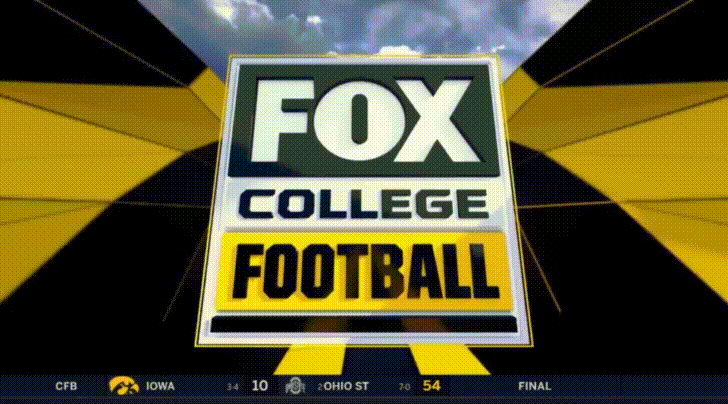
I could take a clip of something like this from pretty much any game:
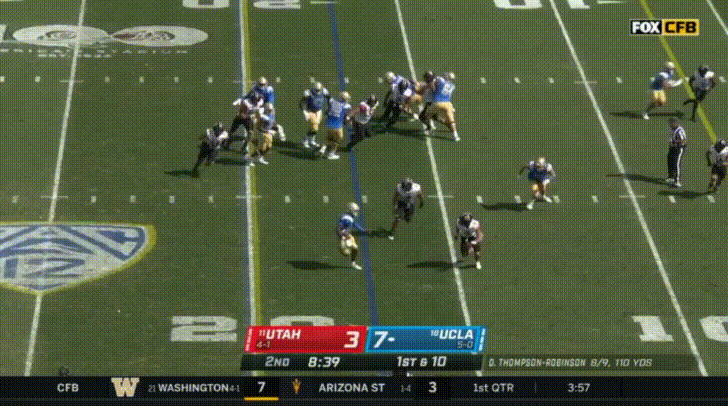
I’m no psychologist, but playing with such an attitude seems like something that could backfire if it were to put you on tilt.
I’m sure this is the type of attitude a fawning announcer would spin positively, because DTR’s competitive fire has him doing things like this:
This isn’t just a one-off example either; DTR will quite often try to block for his running back, for seemingly no reason other than his desire to hit someone. Of course, this will win you points in the locker room, but… this is your super-senior quarterback we’re talking about. The engine that drives this offense should not be putting himself in harm’s way so often. The flipside of this sort of attitude is that it leads to plays like this:
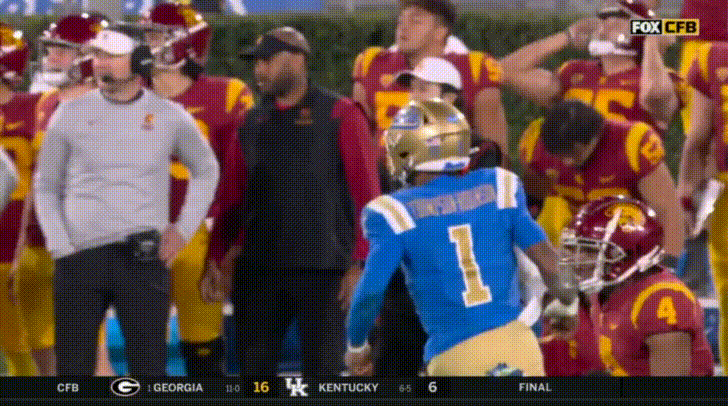
A UCLA apologist would say that a lot of DTR’s struggles could be attributed to him playing hurt. In the above clip, you can see that DTR’s wrist and index finger on his throwing hand are already taped up, which is less than ideal for your quarterback. An NFL coach might be able to clean up DTR’s throwing mechanics, but I’m going to guess that the constant injuries he has to play through aren’t helping his accuracy either.
I think the desire to talk trash to basically anyone who looks at him funny is an attempt to keep his motivation and focus high. As such an emotional player, when he starts to lose confidence in himself, his play noticeably suffers:
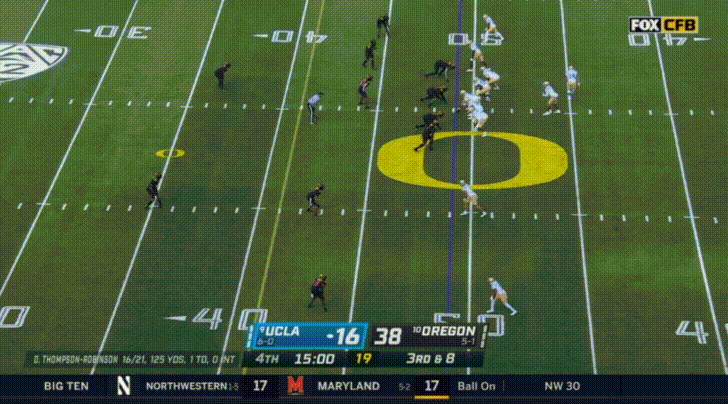
Normally I would start this section with highlights of a quarterback’s throws, but… I don’t have any DTR passing highlights from this season. I think that’s a function of the way that Chip Kelly and the UCLA offense will scheme receivers open; using misdirection or tricky plays to get receivers (or running backs) lost in coverage, so that DTR can find the open man. Or, alternatively, DTR just throwing it up and letting his receiver haul it in, in which case I usually credit the receiver for the completion.
So to start with the positives, let’s look at DTR’s running ability and mobility in the pocket.
If DTR weren’t a quarterback, he’d still make a fantastic running back. I mean, this is a nicer cut than most running backs make:
DTR is extremely elusive in the pocket, and a homerun threat just running the ball (which is something I wouldn’t say about 90% of the RBs I watch):
DTR loves seeing tacklers go low because he always wants to hurdle defenders, something I’m fearful of ever since I saw Jahvid Best do it in 2009. Is the defense focused on stopping the UCLA receivers and no one is open? No matter, DTR can handle it:

DTR has good pocket awareness and does a great job of escaping sacks, even when defenses bring pressure:
DTR runs the Run Pass Option (RPO) offense better than anyone in the Pac-12. DTR makes good reads in the RPO, and can punish opposing defenses more than any other QB running the ball:
Because UCLA also has a stellar running back who similarly commands the defense’s attention, DTR will find opportunities to run into open space for big gains:
Even ignoring his shiftiness as a runner, he has straight-line speed:
DTR is also great at improv, when the play breaks down for any reason. This looks like a busted play, but three USC defenders knew what he was about to do and still couldn’t stop him:
For the most part—without highlighting any part of the passing game—that’s been enough for UCLA this season. UCLA has won a ton of games on their rushing ability alone, especially with such a great runner at QB.
On the other hand, when defenses can really force DTR into passing situations, UCLA is vulnerable. He’s often making either very poor reads or very poor throws (I can’t tell if DTR didn’t see someone/didn’t read the defense correctly, or he did read the defense correctly and made a terrible throw anyway).
In the following play, DTR has predetermined where he wants to throw this ball, and probably doesn’t see that a linebacker that was showing blitz has dropped back into coverage:
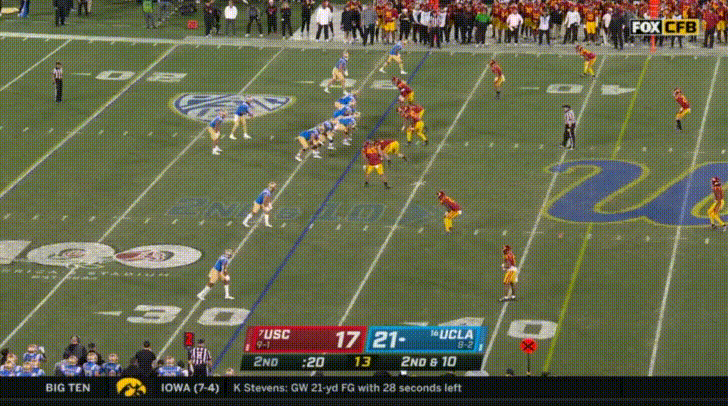
In the following play—with UCLA behind—DTR works some magic with his feet to escape a sack, but just lofts a dumb pass up into a sea of white jerseys (he’s trusting his top receiver, Jake Bobo, to make this play, and although Bobo is really good… this looks like DTR thought he was throwing to Calvin Johnson):
UCLA has a very strong offensive line, but if an opposing defense is able to get pressure on DTR, his throwing mechanics tend to break down:
I’m not sure if DTR was psyched out by Stanford’s 4D chess move here (Why is my receiver this wide open? Is this a trap?), but here DTR has no pressure, a wide open receiver, and he still manages to fire an inaccurate throw:
Poor throwing form here results in an interception:
I won’t even pretend I know what went wrong here, but this play should have worked:
And here’s another throw where I’m not sure if DTR intended to fit this throw over the linebackers or if he just had no idea that there would be linebackers sitting there:
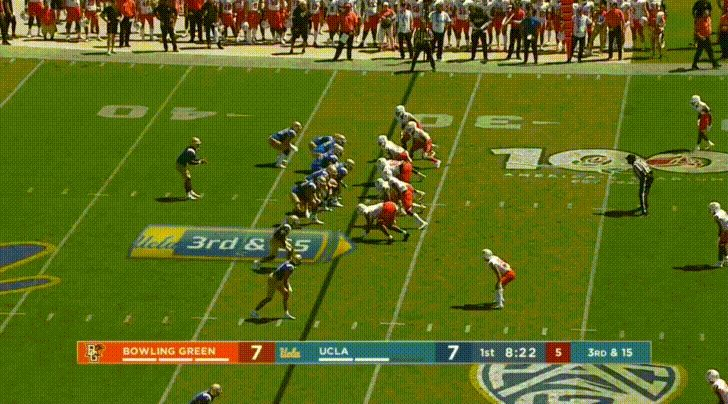
Probably not going to be a factor in this game, but the backup QB is a really solid passer. He’s mentally tough, because he has to play with the knowledge that he is a constant disappointment to his parents after settling for such an inferior university. I’m talking about Ethan Garbers, the brother of 2019 Big Game Hero Chase Garbers:
He’s no Chase, but he still has decent pocket mobility:
This is one of those situations where the plan to stop UCLA is a lot easier said than done. Keep the UCLA run game contained and force DTR to throw the ball, and the UCLA offense is in big trouble. The problem is that if a team like Utah could struggle to do so, it’s hard to believe that Cal could.
Running back
UCLA is led by running back Zach Charbonnet, an absolute wrecking ball of a man. Per PFF, he has forced 46 missed tackles this season, which ties him with the absolute best running back in the conference, Jaydn Ott. (But because UCLA’s offensive line allows Charbonnet to break tackles after the line of scrimmage instead of before it, Charbonnet leads the Pac-12 in rushing yards, and Ott is in 6th). Charbonnet, a transfer from Michigan, is one of the top RB prospects in the upcoming NFL Draft. He’s got great size and strength, he’s an excellent downhill runner, and he’s way more elusive in open space than a back his size has any business being. The one real knock against him, and probably what will cap his NFL potential, is that he lacks the breakaway speed to be a homerun threat out of the backfield. However, he averages an absurd 7.3 yards per carry, which is a big part of why the UCLA offense is able to drive down the field with such consistency and efficiency.
Defenses absolutely dread trying to tackle Charbonnet in open space. He’s a receiving threat out of the backfield (as a way to stretch the defense horizontally), and he pretty much never goes down on first contact:
The UCLA offensive line will provide Charbonnet plenty of opportunity to get into open space. Despite being the obvious short yardage back, he’s able to punish some weak Stanford tackling with a touchdown:
There arm tackles just aren’t going to cut it:
Charbonnet has great balance and lower body strength, and is able to keep his feet on contact:
One thing I like about Charbonnet is that he has really good patience and vision. He knows when to let blocks to develop and when to attack an open lane (even if it’s not the one drawn up in the play call):
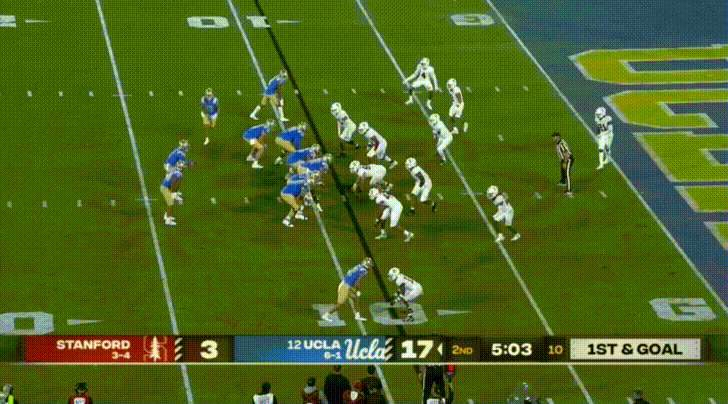
Charbonnet is just really polished as a running back. He has excellent moves in open space:
While defenders in the open field are internally panicking about how they’re going to wrap him up, Charbonnet will just make them whiff completely:
I’m always fond of running backs that can create their own yards. Here his first read is not there, but he stays patient and makes a really nice cut to pick up the first down:
Prior to this year, UCLA had some ridiculous stat line about being undefeated when Charbonnet rushes for at least 100 yards (there are two exceptions this year: Oregon and Arizona, whose high-powered offenses were able to capitalize on the few defensive stops they were able to get on UCLA). Otherwise, the only way to stop UCLA was to stop Charbonnet, which is a really tall order.
Behind Charbonnet, UCLA has a variety of different running backs. There’s Keegan Jones, a good receiving target with some speed and good vision:
He’s not known for his elusiveness, but he can make a defender miss:
In recent games, the RB/WR Kazmeir Allen has received a lot more touches. Kazmeir (“Kaz”) Allen was recruited to UCLA as a running back in 2018 (the same year as DTR), but he was primarily known for his speed, as the California state champion in the 100m dash. After his freshman year, with a crowded running back room, Chip Kelly converted Allen to wide receiver, where he could use his speed to get separation from defensive backs. UCLA has a strong defensive line, so Allen is just the type of running back that can hurt a defense if he gets room to accelerate:
And if he gets a full head of steam, you can say goodbye:
Like DTR, Allen is also a homerun threat:
The most interesting back is the former Washington quarterback, Colson Yankoff. With Charbonnet out with an injury, UCLA turned to the linebacker-sized Colson Yankoff in short yardage situations:
I’m always suspicious whenever a former QB is playing RB, because they always have that double pass play in their back pocket.
Cal will need to do their best to contain Charbonnet on the ground.
Receivers
UCLA’s best receiver is the 6’5” Duke transfer, Jake Bobo. Bobo is another UCLA player with NFL Draft potential, and while he won’t be a #1 receiver, he definitely has the skills to still be a solid contributor at the next level. Bobo shows good hands, and is a primary reason why DTR’s passing stats are as good as they are this year:
Here’s another pass showing his nice catch radius:
Bobo has some sharp route-running ability for a receiver of his size:
Here’s that same route again, but this time against much stronger competition:
Cal has historically struggled against big pass-catching tight ends. The former walk-on, TE Hudson Habermehl, is a solid receiving threat. The following play looks just like something (former UCLA TE) Greg Dulcich would do to Cal:
On the other hand, this guy wears sunglasses at night. I’d tell you we’re not dealing with the best and brightest here, but that was implied when you opened this article about UCLA.
The other tight end, Michael Ezeike, is typically used for pass-blocking purposes, but he’s shown some nice yards after the catch ability as well:
So many defenders go low against big offensive players to avoid targeting these days, but it results in a lot more plays like this:
Another versatile player I already covered was the RB/WR Kazmeir Allen, the #2 receiver behind Bobo. Most often lined up as a slot receiver, UCLA will definitely use his running ability there as well:
Allen uses his speed to get separation:
Lined up out wide is Kam Brown, a solid contested catch option:
Having a breakout year this year is Logan Loya, who does a good job of finding open space:
There’s another talented young receiver in Titus Mokiao-Atimalala, who I always note due to the difficulty of qucikly typing his name into my notes when I am watching games:

The general theme here is that the UCLA receivers are generally pretty good at getting open and making tough catches, which has really helped elevate the passing stats game of DTR.
Conclusion
Cal’s success will entirely depend on their ability to slow the UCLA run game. Both their quarterback and running back are superb running the ball, and their RPO-offense is about as difficult to defend as the triple option. UCLA will probably win the game, but they also probably struggle with an inner voice that fills them with doubt. It’s probably debilitating to know that your inner pessimist is right, so if you see your local UCLA fan, please take pity on them.
Go Bears.
You can find my full clips here.


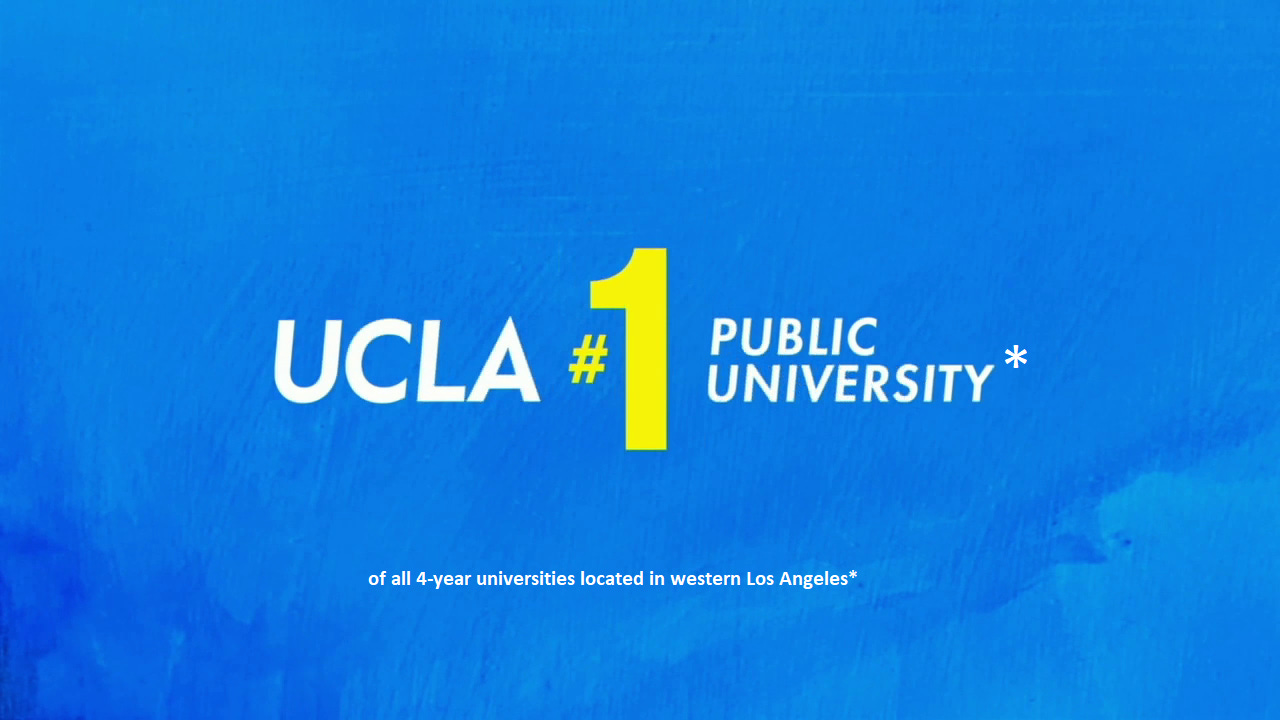
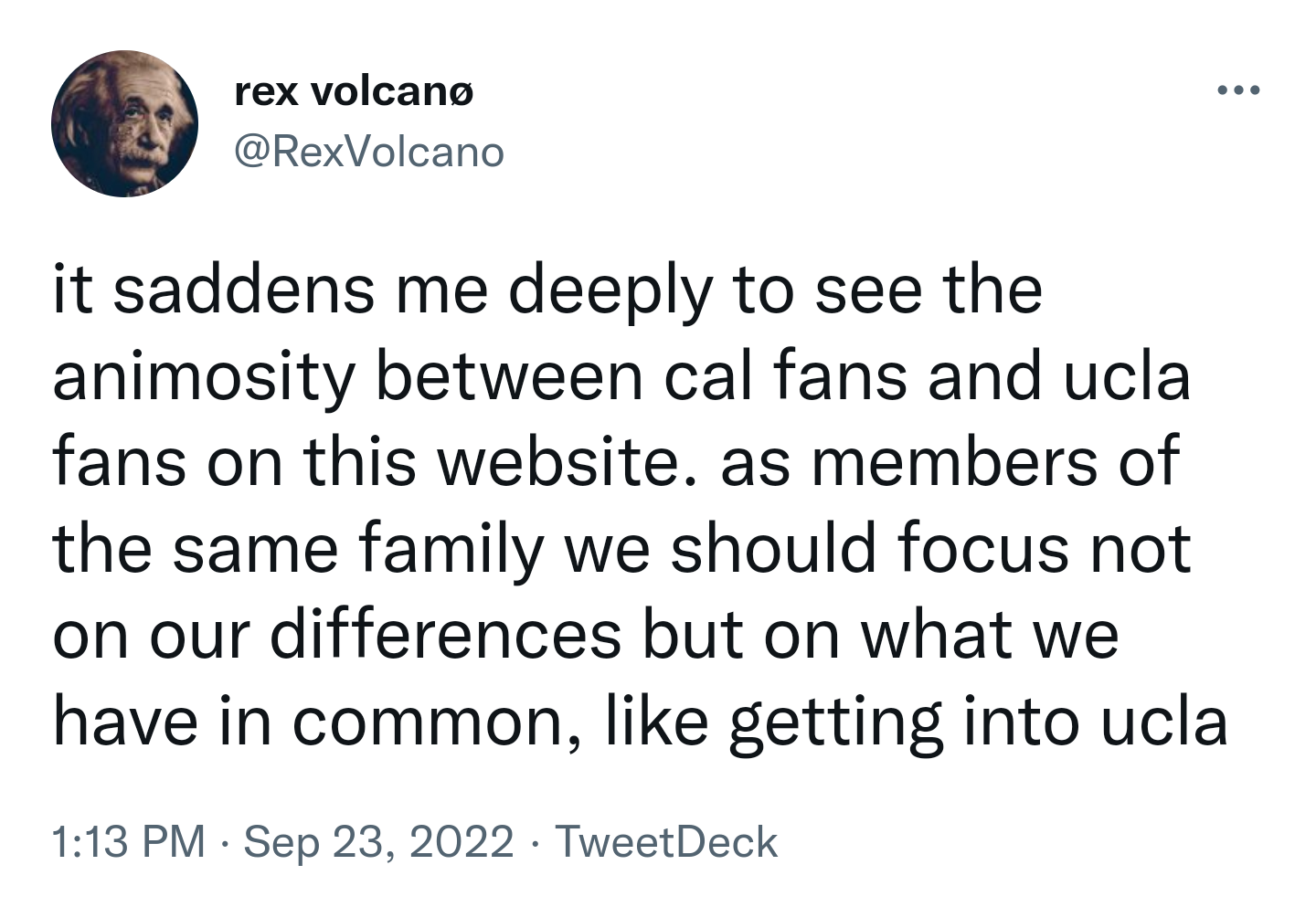
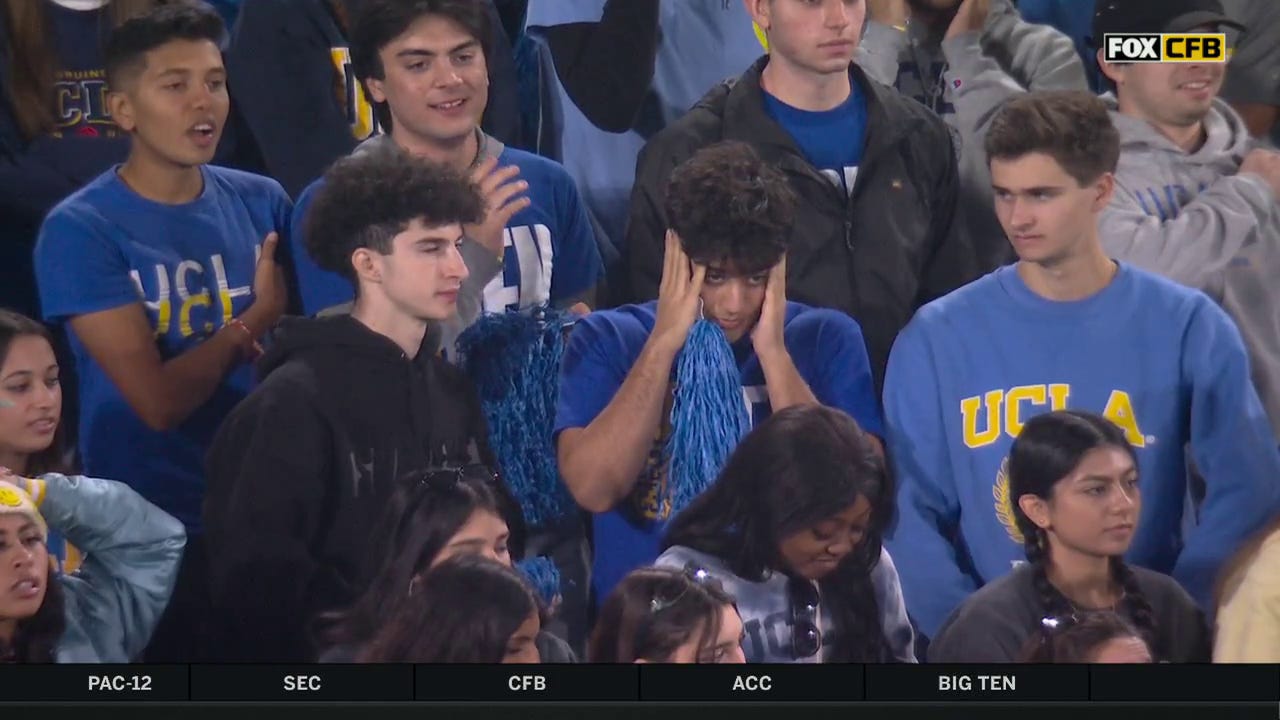

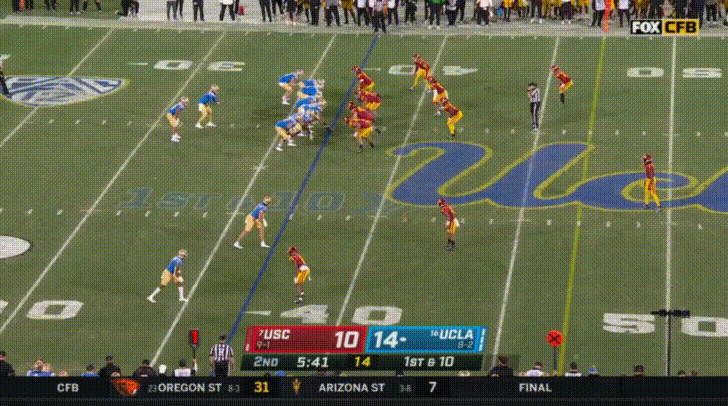

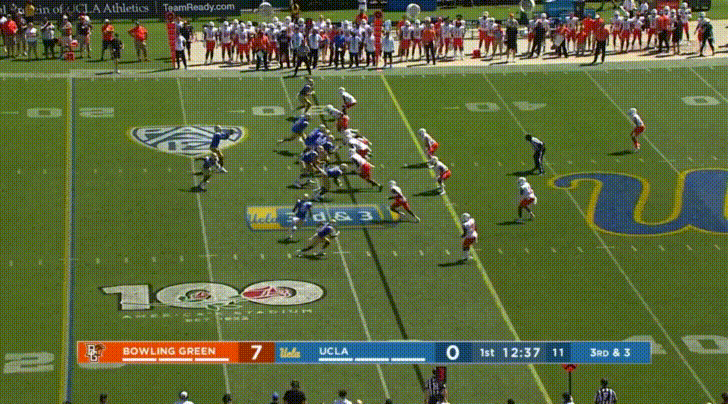

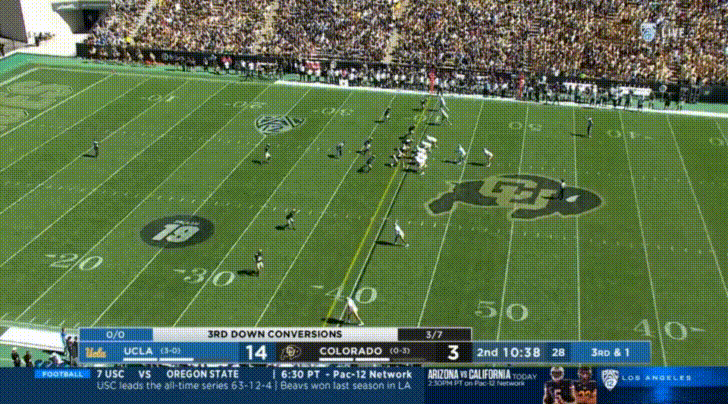
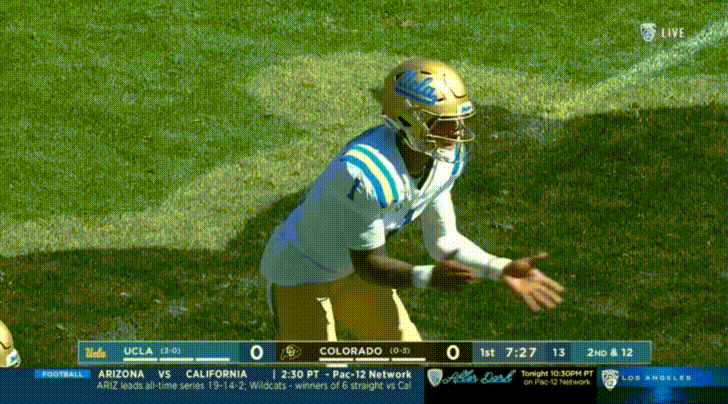
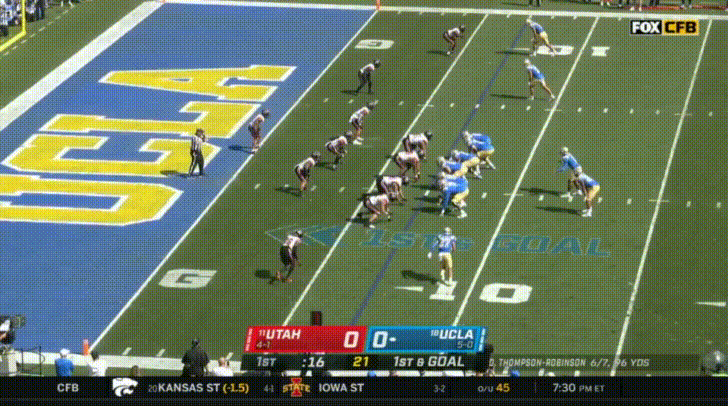
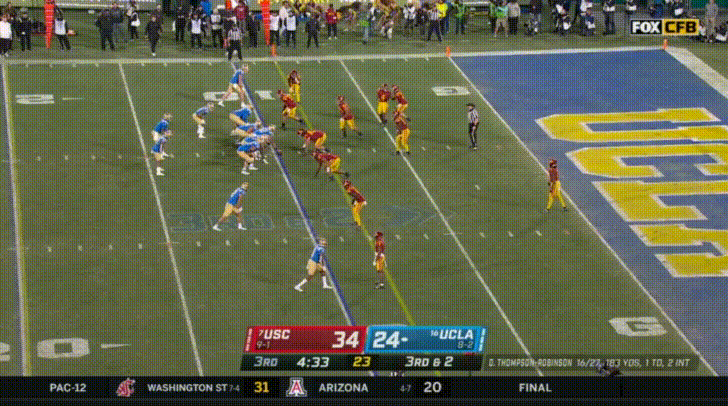


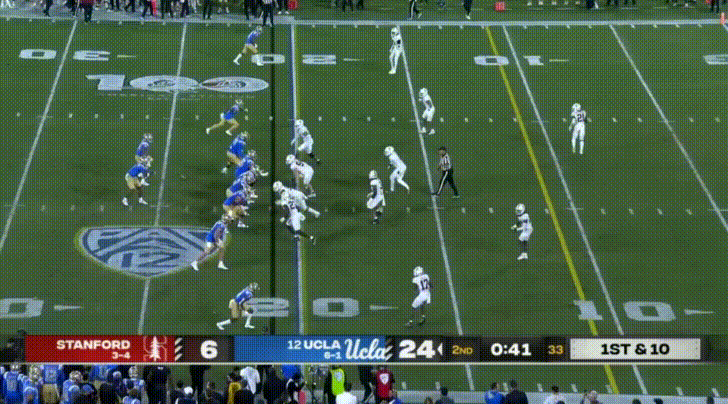



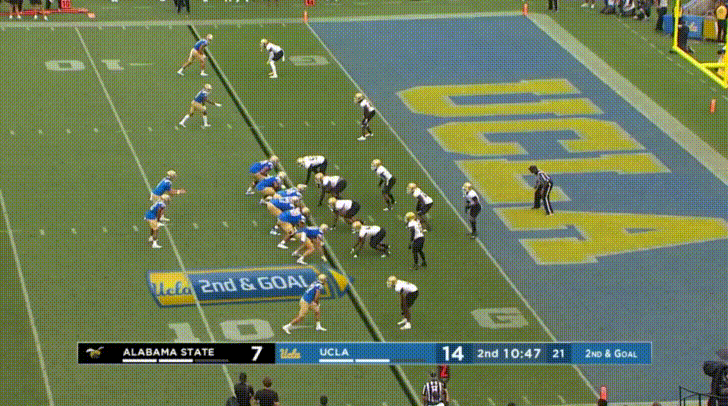

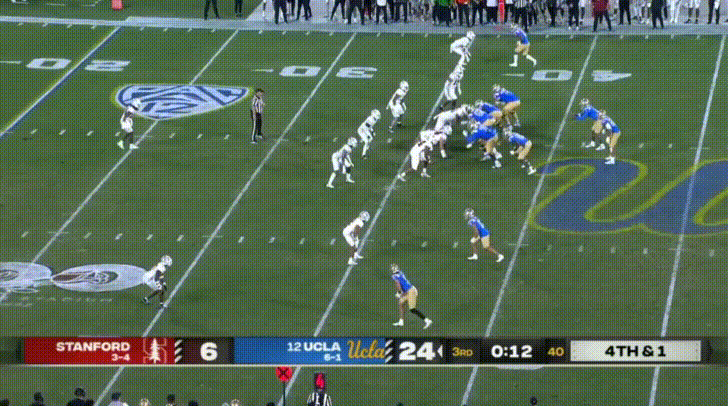
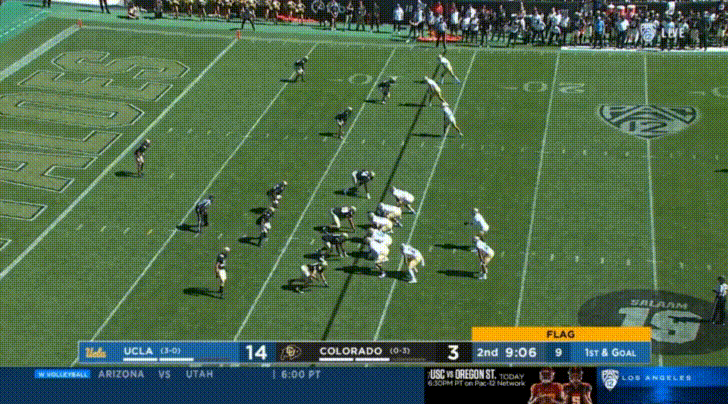

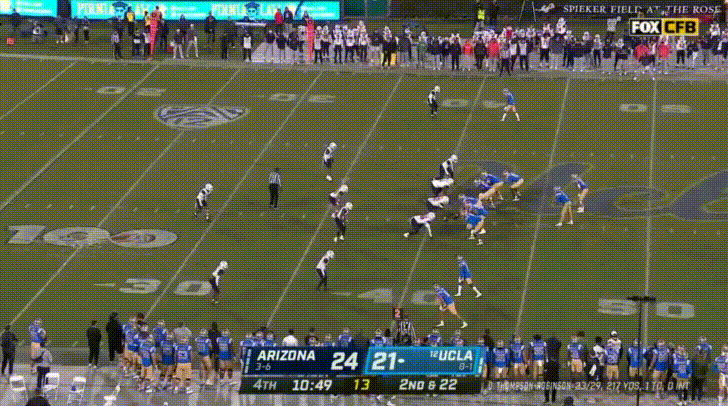
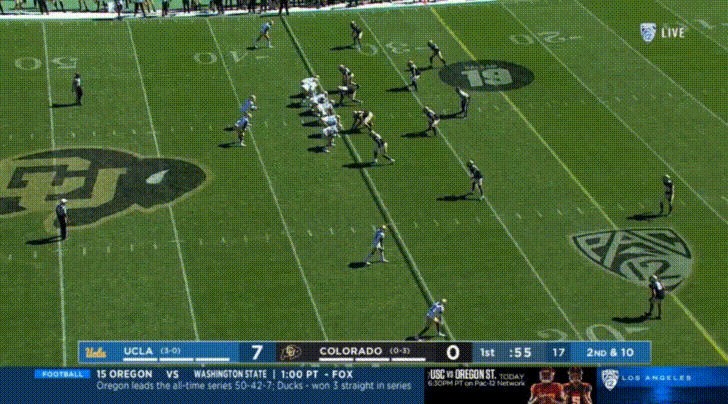
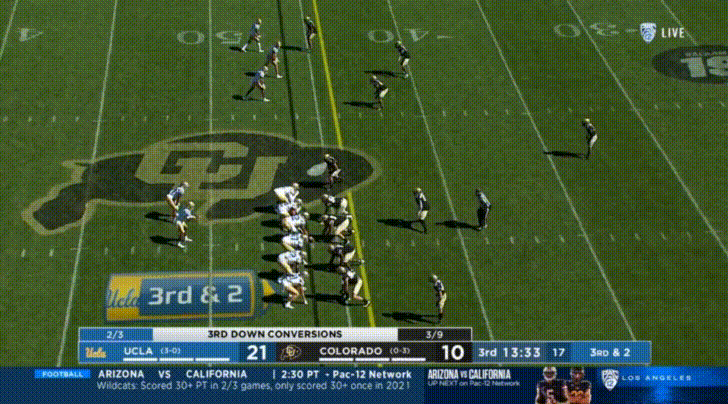
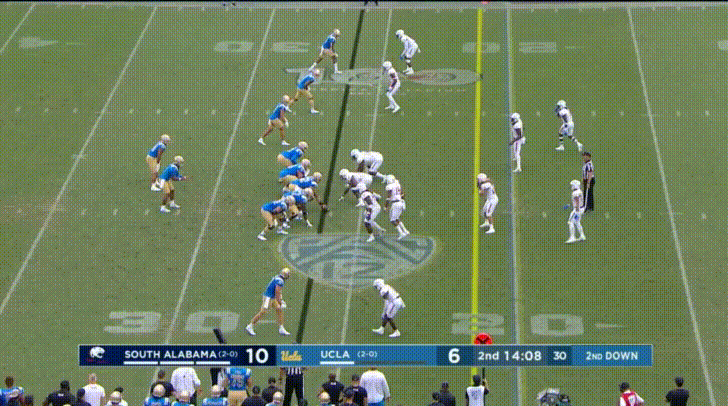

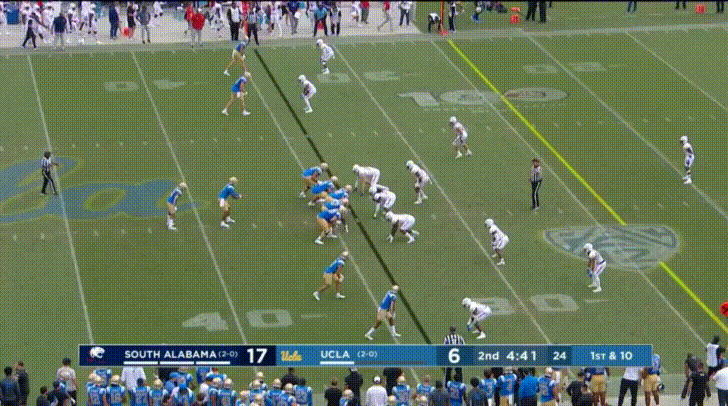
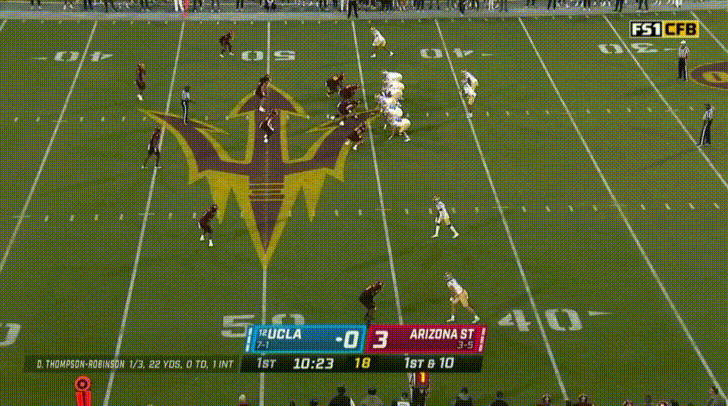
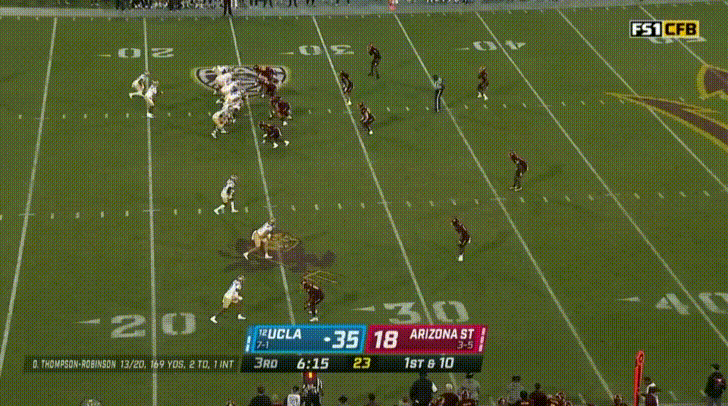

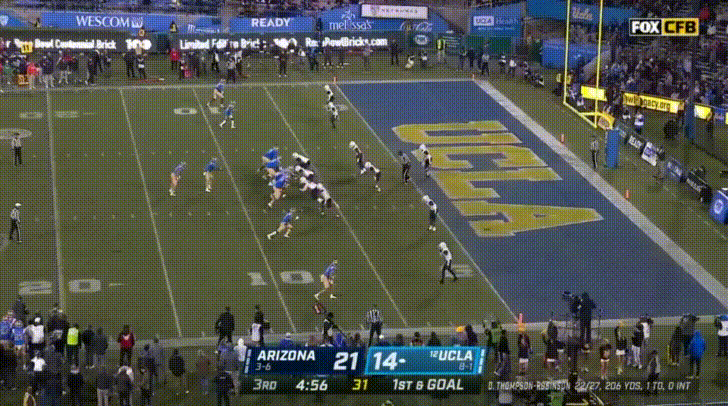


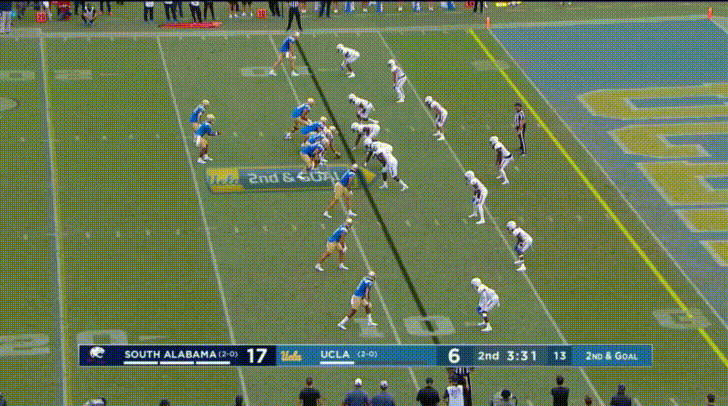

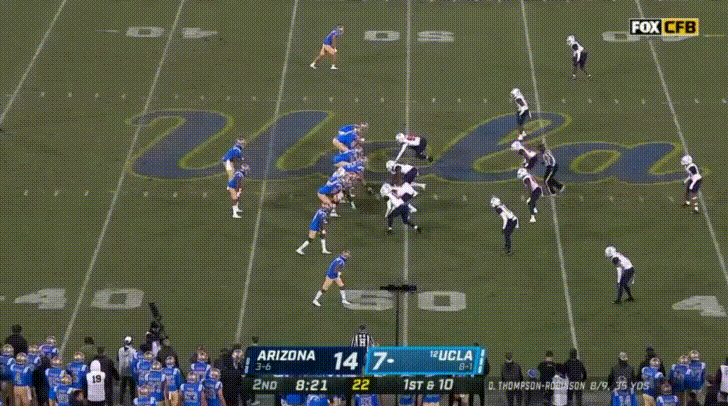
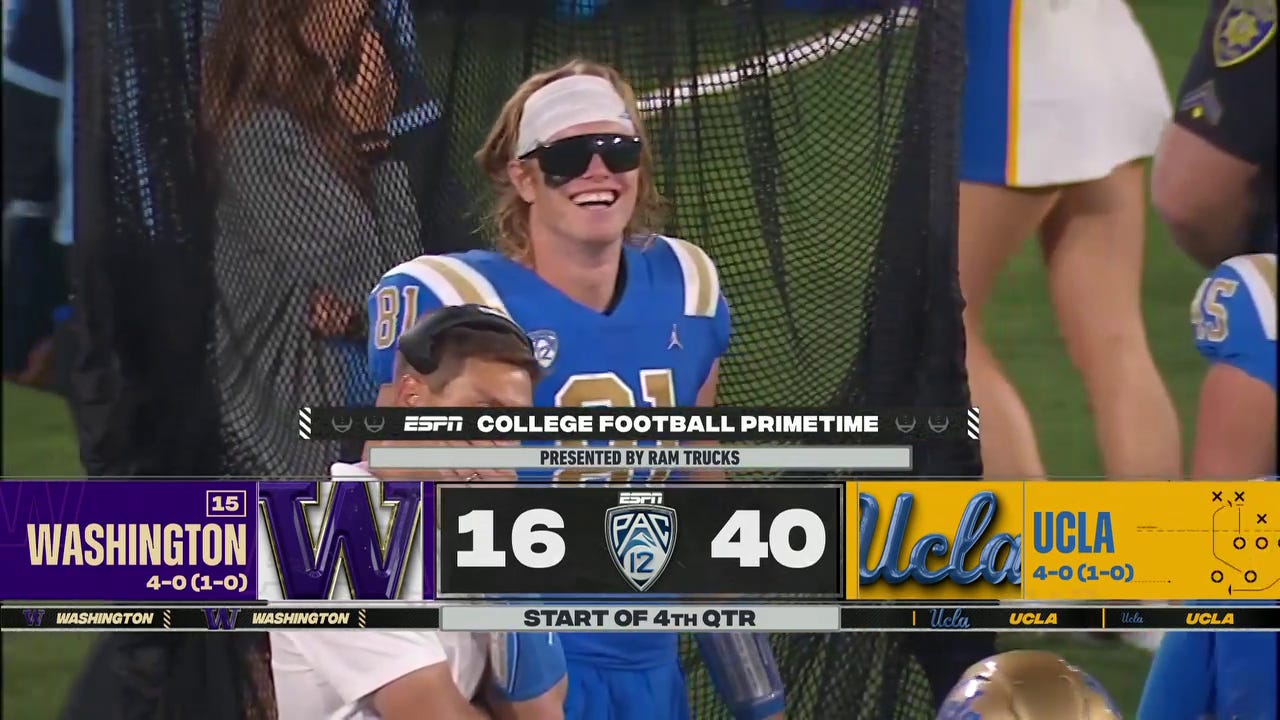
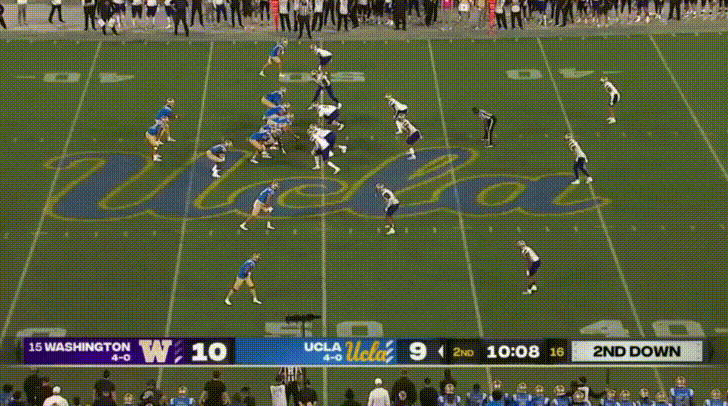
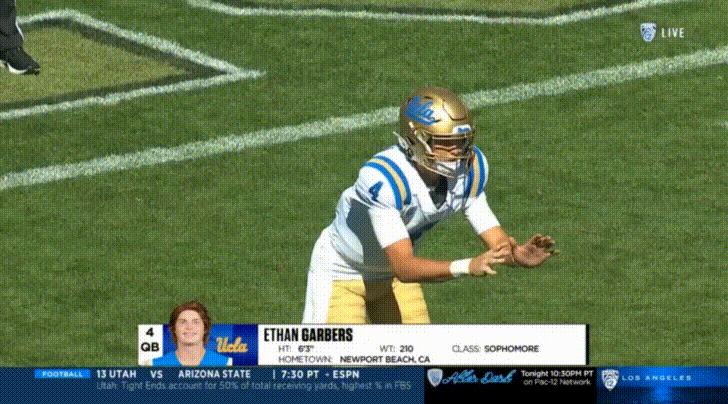
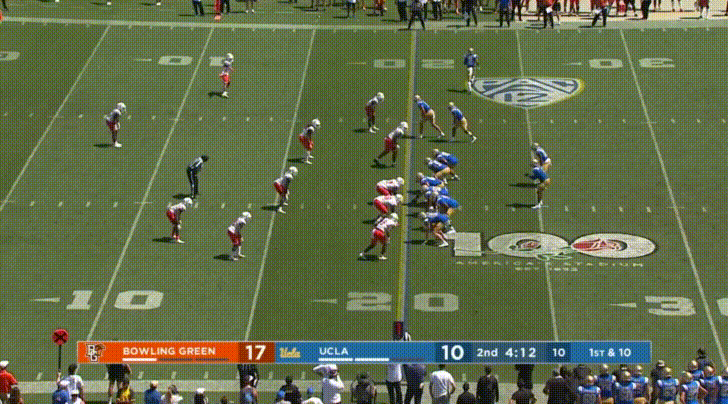

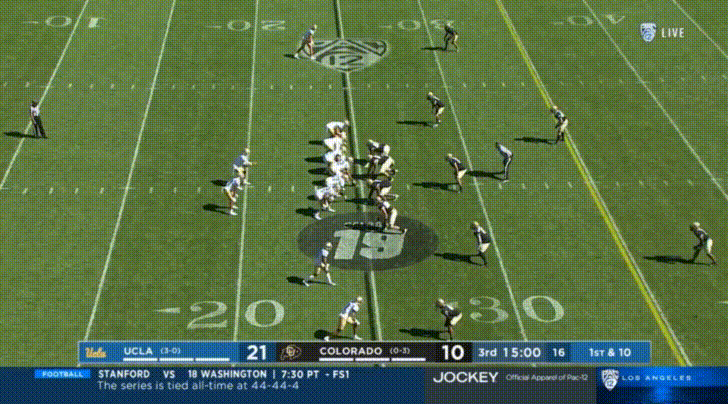

I remember seeing that same ad a couple of weeks ago and rolling my eyes.
Thanks for the super-detailed write-up Christopher.
While you have enumerated fUCLA's strengths, you have also pointed out their weaknesses - and that's why Cal is going to win on Friday afternoon. Also, we outnumber UCLA in terms of Nobel Laureates 22-8, not even close!!!